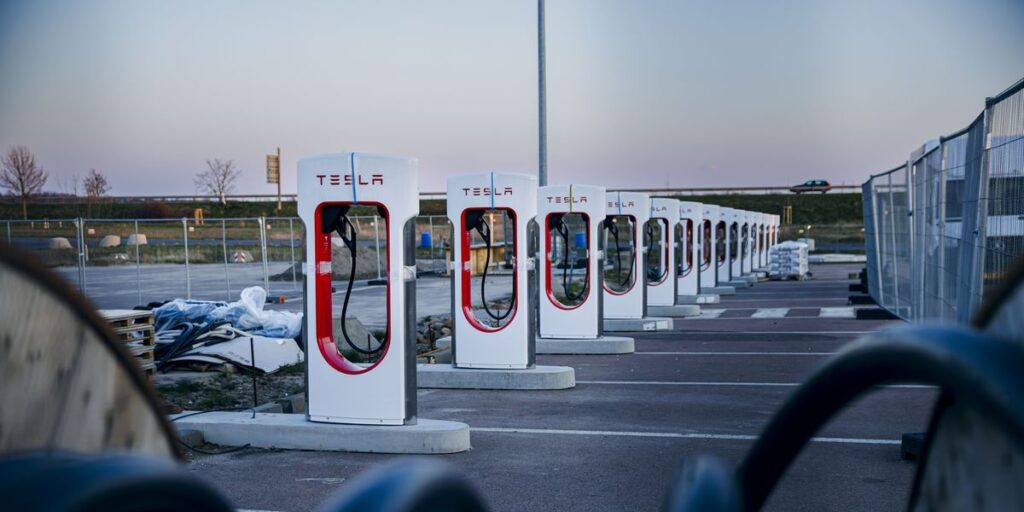Ford Will Use Tesla EV Charging, but That's Only Part of the Story

The surprise announcement late Thursday that Ford will offer present and future owners of its electric vehicles access to more than 12,000 stations in the Tesla Supercharging network came as a shock to most of the auto industry. Tesla has notoriously gone its own way, and the unpredictable and increasingly political behavior of its CEO has certainly been in the news, to say the least.
Setting all that aside, the two companies’ CEOs jointly announced that future Ford EVs will incorporate the Tesla connector from 2025, and current Ford EV owners will have access to Superchargers starting in spring 2024 via a CCS-to-Tesla connector. (Tesla refers to its plug and connector design as the North American Charging Standard or NACS, although many engineers have objected to that usage since Tesla has not followed the process by which a technical standard is traditionally developed.)
Brilliant Move for Ford
Speaking personally, I think the deal is a brilliant move on Ford’s part, for several reasons. First, it will give Ford a huge marketing advantage over every other maker of EVs that isn’t Tesla. Second, it puts extreme and public pressure on existing fast-charging networks—Electrify America, EVgo, and others—to up their game substantially in the area of reliability. Finally, it remains unclear whether Ford will replace the existing CCS/J-1722 connector altogether in its future EVs or simply add the Tesla connector alongside it.
Ford has long recognized that public fast-charging is a mess. Its very first Mustang Mach-E in late 2020 included the Plug and Charge protocol, allowing a user to plug in and have all the validation and billing happen on the back end. In October 2021, it established a fleet of “Charge Angels” who drove Ford EVs to different public charging stations to test whether they could actually charge . . . which was often enough not the case to prove the need.
Ford has also played hardball with charging networks, threatening to remove sites or parts of entire networks from its aggregated BlueOval Charge Network of charging sites if they weren’t fixed, pronto. Now, with this one move, it has doubled the number of fast-charging sites available to Ford EV drivers, and given them access to what is unquestionably the most reliable EV fast-charging network in North America.
Tesla, in return, will get significant revenue out of the deal, perhaps offsetting the many billions of dollars it has spent setting it up over 11 years (costs that have never been broken out on its balance sheets). That income will help its plan to expand its network of Superchargers (and lower-speed Destination Chargers) significantly by December 2024. Perhaps it can also point to Ford’s signing up as evidence that its connector should be a “standard.”
The Marketing Advantage
Until you drive an EV, you don’t necessarily appreciate the importance of ubiquitous, reliable, tightly integrated public fast charging to making it practical for road trips. Tesla did, and because its Model S was the sole EV in 2012 with range of more than 200 miles, it knew it had to have a reliable network—so it built one, tightly integrated the charging, the navigation, and the billing together. In that respect, it’s like Apple: It controls the entire ecosystem.
Now Ford will become the sole carmaker aside from Tesla itself able to tell buyers, “You can charge your EV at any charging site in the U.S.” Owners of current Ford EV models will have to buy a Tesla-designed adapter, which I trust the two makers have agreed to produce in sufficient volume. Owners of Ford’s next generation of EVs will have the Tesla port built right in; they can presumably pull up to a Supercharger and just plug in.
That’s a huge advantage over Tesla’s current model of enabling a limited number of Supercharger cables to charge CCS-equipped cars via its Magic Dock automatic connector. That connector is automatically enabled when the non-Tesla CCS driver uses the Tesla app to reserve a Magic Dock–equipped pedestal at one of the few Supercharger sites that has one.
The Heat Is Now on Electrify America
Much has been written about the unpredictability of non-Tesla public charging sites. Reliability and comfort at least on a par with a gas station hardly seems like a high bar, but it’s simply not there. Carmakers’ frustration by now is “off the charts,” said one source—who, like the other five interviewed for this piece, insisted on anonymity to preserve industry confidentiality. The Ford/Tesla deal is “a major shot across the bow” for Electrify America and the other networks, he said.
Today, no existing fast-charging network is making money. They are in a land-grab phase, trying to get as many stations in the ground as fast as possible to lock up desirable sites—and, in the case of Electrify America, to comply with a 10-year consent order with the EPA resulting from VW Group’s culpability for the Dieselgate scandal as well.
The Trouble with Current Charging
That means any missed revenue, from the customer who drove an EV to a charger only to find it broken, is irrelevant. And very few incentives exist to keep stations in working order. So Ford’s deal with Tesla immediately puts huge pressure on Electrify America, EVgo, ChargePoint, and smaller networks that offer public charging. In effect, Ford can say, “If you don’t bring your network up to Tesla standards, we can always direct our customers to Tesla—which we know works properly. And you know that too, don’t you?”
Ford’s electric F-150 Lightning and Mustang Mach-E.
Ford Motor Company
Will Ford Dump CCS?
While Ford CEO Jim Farley talked about the deal as a “breakthrough agreement” that would be “great for customers,” the language in the official announcement discussed “access” to Tesla charging. It specifically did not say Ford will abandon the existing CCS connector in its future cars. Nor was that directly stated in a Twitter chat between the two companies’ CEOs. When questioned on this point, multiple Ford reps responded with versions of, “More details to come, stay tuned.”
Will CCS Go Away Altogether for Ford?
It’s far from certain that Ford will drop the combined J-1772 and CCS connector. And because the Tesla connector is so compact, adding it will take up less real estate than the reverse. Some European and Asian cars are now sold with rectangular fuel filler doors, to allow the same body stampings to be used for diesel models sold outside North America that have a second filler for Diesel Emission Fluid. That same form factor might easily allow a Tesla port to be added next to the CCS port.
Dropping J-1722, the Level 2 charging connector now used by every EV sold in the U.S. except Tesla—which even provides a J-1722 adapter to its customers—would mean owners of future Ford EVs would have to use an adapter for every one of the Level 2 public charging cables in existence today. That’s not customer-friendly.
And dropping the CCS connector would mean using a separate, much larger adapter to charge at any of the tens of thousands of charging stations using it, to be paid for by $5 billion of National Electric Vehicle Initiative funds the federal government is distributing through all 50 states. Would Ford really walk away from all those new fast-charging stations—requiring owners to use a cumbersome adapter rather than simply plugging in as they do now?
Finally, Ford was surprised at the public fascination with the idea that an F-150 Lightning could power a house for up to three days (with several asterisks). That’s known as vehicle-to-home, or V2H. It’s the last step before vehicle-to-grid, or V2G, in which the vehicle can support electric grid stability via two-way charging. The Tesla connector is resolutely one-way, and it has no current provision even for using a Tesla as home-backup power. Again, hardly customer-friendly.
I suspect that at least initially, Ford will add the Tesla connector alongside CCS/J-1772 in its new generation of EVs. That would allow it to say, “Not only can you charge your EV at any charging site in the U.S., but . . . you can do it without carrying a single adapter.”
That’s something not even Tesla can claim. While there are many reasons why Ford may choose not to build two different DC fast-charging connectors into their future EVs, I believe—and sources suggest—there are multiple reasons that’s exactly what’ll happen.
Who Will Own EV Charging in 2030?
Despite modern EVs being on sale for 12 years now, we’re still in the early days of figuring out how to cover the big, sprawling U.S. with sufficient numbers of DC fast-charging stations to enable the EV transition that’ll take place over the next 30 years. But then, early gasoline drivers had their own version of range anxiety too.
It remains unclear whether the existing networks will even be around in 2030. Smaller networks will likely be rolled up into bigger ones, but other players are equally provide EV charging over the long haul: electric utilities (which buy or produce the power regardless), convenience-store operators, fossil-fuel companies, perhaps even carmakers themselves.
But in one fell swoop, Ford’s action put all the existing charge networks on notice that what they’ve offered isn’t nearly good enough. It covers all the charging bases. Most of all, it’ll reduce the anxiety of driving an EV long distances. At least, if it’s a Ford or Lincoln EV.
Tesla may well do other similar deals. But Ford has gotten there first, and all EV drivers are likely to benefit in the long term.

Contributing Editor
John Voelcker edited Green Car Reports for nine years, publishing more than 12,000 articles on hybrids, electric cars, and other low- and zero-emission vehicles and the energy ecosystem around them. He now covers advanced auto technologies and energy policy as a reporter and analyst. His work has appeared in print, online, and radio outlets that include Wired, Popular Science, Tech Review, IEEE Spectrum, and NPR’s “All Things Considered.” He splits his time between the Catskill Mountains and New York City and still has hopes of one day becoming an international man of mystery.



